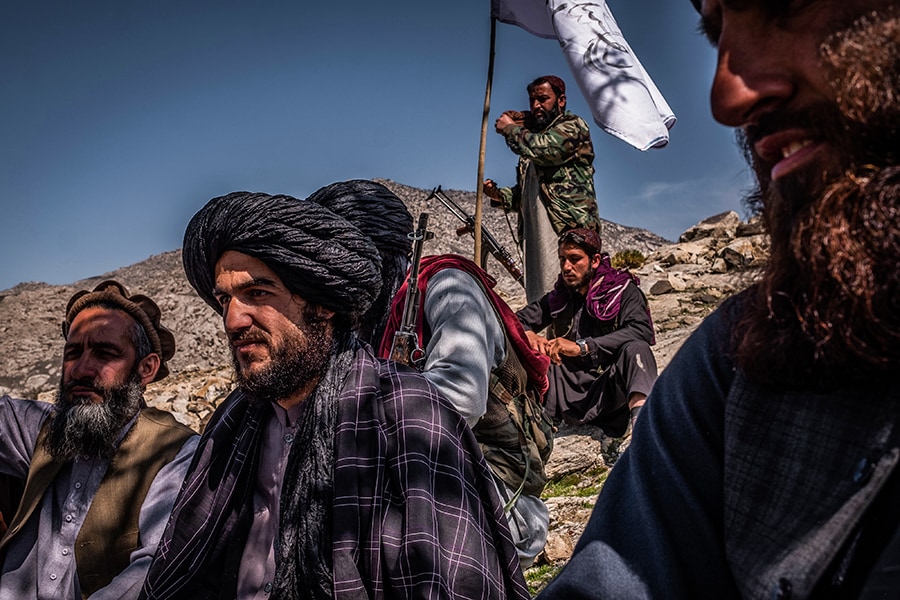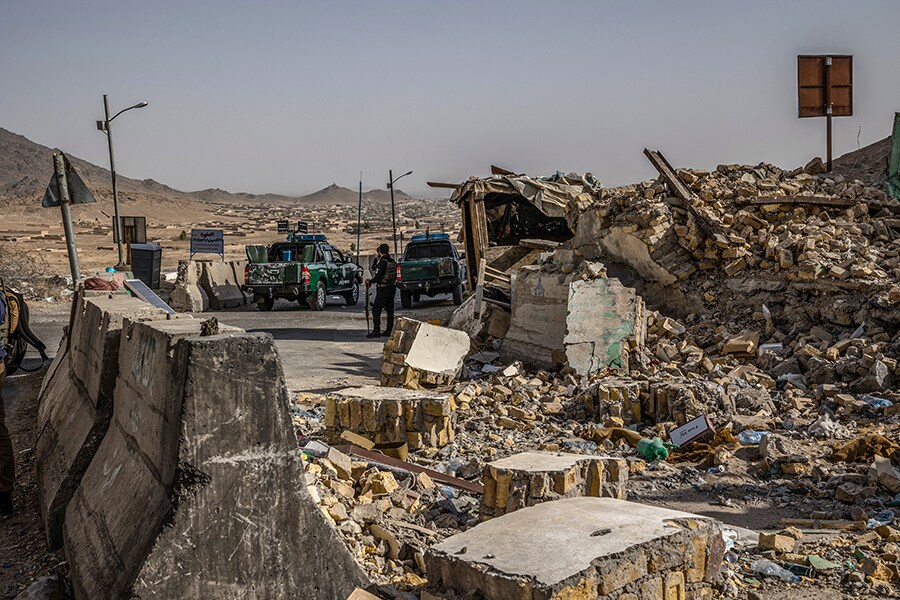With the Taliban’s sudden gains in Kandahar, in the country’s southern Pashtun heartland, and Herat, a vital cultural and economic hub, the insurgents appear to be nearing a complete military takeover. Only four major cities — including the capital, Kabul — remain under government control, and two of them are under siege by the Taliban.
Over the past week, the Taliban have toppled city after city in a stunning advance that has well positioned the insurgents to attack Kabul. It has also laid bare the Afghan security forces’ nearly complete collapse less than three weeks before the United States is set to completely withdraw. Some U.S. officials fear the Afghan government will implode within 30 days and are preparing for an evacuation of the U.S. Embassy in Kabul.
It was a devastating 24 hours for government forces in Afghanistan.
Both Kandahar and Herat had been heavily defended, with battles raging for weeks. But increasingly, the Afghan security forces were overrun, with many soldiers and policemen reported to be deserting or even changing sides in some places.
Kandahar, in particular, is a huge prize for the Taliban. It is the economic hub of southern Afghanistan, and it was the birthplace of the insurgency in the 1990s, serving as the militants’ capital during their five-year rule. By seizing the city, the Taliban can effectively proclaim a return to power, if not complete control.
For weeks, a mix of Afghan army, commando and special police units have desperately tried to hold Kandahar city as it came under Taliban siege. Then on Wednesday, the insurgents overran Kandahar’s central prison, freeing hundreds of inmates and in the process swelling their ranks — a tactic practiced for well over a decade.
By the following evening, Taliban fighters had broken through nearly every front line surrounding the city, according to members of the security forces.
Many Afghan forces retreated to the governor’s compound, which came under attack. The road to Kandahar’s airport also came under heavy fire from Taliban fighters. Within hours, nearly all commando and special police units had fled the city, effectively handing it over to the Taliban, according to officials and witnesses.
At the same time, to the northwest, the Taliban effectively seized control of most of Herat after security forces retreated.
For weeks, Afghan forces and militias loyal to Ismail Khan, a former warlord, struggled to fend off the insurgents as they advanced deeper into the city. But even with the added support of Afghan and U.S. air campaigns that have tried to slow the Taliban’s advance, security forces could not hold back the insurgents, officials said.
![]() A police outpost in Kandahar, Afghanistan on Aug. 4, 2021, that was destroyed by the Taliban. Two major cities in western and southern Afghanistan were on the verge of collapse to the Taliban on Thursday, Aug. 12, 2021, as the insurgency’s race to seize control of the country accelerated Image: Jim Huylebroek/The New York Times
A police outpost in Kandahar, Afghanistan on Aug. 4, 2021, that was destroyed by the Taliban. Two major cities in western and southern Afghanistan were on the verge of collapse to the Taliban on Thursday, Aug. 12, 2021, as the insurgency’s race to seize control of the country accelerated Image: Jim Huylebroek/The New York Times
On Thursday, the Taliban broke through the front lines on the outskirts of the city and gained control of most government buildings, including police headquarters, as officers fled in civilian clothes, according to a spokesperson for the Herat police. The Taliban also seized Khan’s house — a symbolic prize that signaled the defeat of his militia forces. By Thursday evening, only the army corps compound remained under government control.
“Most compounds collapsed without fighting," said Sami Nusrat, a spokesperson for the Herat police. “Some compounds and houses were burned down by the Taliban. The Taliban are opening fire into the air to celebrate."
Ehsan Shafiq, a resident of Herat city, sheltered in his home Wednesday night after hearing the fighting outside intensify. By the following morning, an eerie quiet had fallen over the city as Taliban fighters flooded into the streets without resistance from government or militia forces.
“When they entered the police headquarters, it was empty, and when they entered the governor’s office, it was empty," he said. “Wherever they went, the forces had already left the area. Now they stand at every square and are placed in government offices."
On Thursday afternoon, the Taliban seized Ghazni, a provincial capital and strategic city about 90 miles south of Kabul. Hours later, they captured Qala-e-Naw, the capital of Badghis province, which neighbors Herat, after security forces retreated to an airport on the outskirts of the city, officials said. And in Lashkar Gah, the capital of Helmand province and the only other major southern city still nominally controlled by the government, the Taliban overran the police headquarters and a prison.
With the fall of Kandahar and Herat, the Taliban will have gained control of more than a dozen provincial capitals in just one week.
The Taliban now control much of southern Afghanistan and the country’s entire western border with Iran. The insurgents have also captured nearly all of northern Afghanistan, once the heart of resistance to the Taliban. The fall of the north has sent morale plunging in the government and the security forces and poses a serious strategic setback.
Two of the four major cities that remain under government control — Lashkar Gah in the south and Mazar-i-Sharif in the north — are already under Taliban attack as the insurgents push for total military victory.
That outcome appears increasingly likely.
This week, the Pentagon began moving thousands of U.S. Marines into position for a possible evacuation of the U.S. Embassy and American citizens in Kabul. American negotiators are also seeking assurances from the Taliban that they will not attack the embassy if the insurgents overrun the capital, two U.S. officials said.
Afghan security forces, exhausted and overstretched by the Taliban’s advance, are giving up across the country. On Wednesday, an entire Afghan army corps in the northern city Kunduz surrendered to Taliban fighters, who had seized control of the city a few days before. They handed over their weapons and vehicles to the insurgents and ceded control of the city’s airport, officials said.
As the Taliban have pressed on their brutal offensive, thousands of displaced people have flocked to Kabul, one of the last islands of government control not yet under siege. Hundreds of thousands of others have been trapped between fighting in city streets and airstrikes from the sky.
“Every second here I am concerned, I am crying," said Humaira Jahion, 47, who fled to Kabul from the northern city Kunduz hours before it fell to the Taliban on Sunday.
For two nights she sheltered in her home with her seven children, afraid to leave after a mortar landed half a block from her house. Now, thinking about her family’s future as she crowded in with hundreds of others in a makeshift shelter, a look of anguish washed over her face.
“There is no future here," she said. “There is no future for me, and there is no future for my children."

 Members of the Taliban in an area controlled by the group last year in Afghanistan’s Laghman Province on March 13, 2020. The American military presence in Afghanistan is set to end and the recent string of Taliban military victories has not moved President Biden to reassess that plan, officials said Image: Jim Huylebroek/The New York Times[br]
Members of the Taliban in an area controlled by the group last year in Afghanistan’s Laghman Province on March 13, 2020. The American military presence in Afghanistan is set to end and the recent string of Taliban military victories has not moved President Biden to reassess that plan, officials said Image: Jim Huylebroek/The New York Times[br] A police outpost in Kandahar, Afghanistan on Aug. 4, 2021, that was destroyed by the Taliban. Two major cities in western and southern Afghanistan were on the verge of collapse to the Taliban on Thursday, Aug. 12, 2021, as the insurgency’s race to seize control of the country accelerated Image: Jim Huylebroek/The New York Times
A police outpost in Kandahar, Afghanistan on Aug. 4, 2021, that was destroyed by the Taliban. Two major cities in western and southern Afghanistan were on the verge of collapse to the Taliban on Thursday, Aug. 12, 2021, as the insurgency’s race to seize control of the country accelerated Image: Jim Huylebroek/The New York Times
